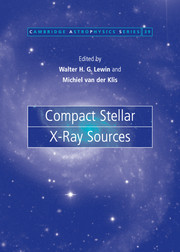Book contents
- Frontmatter
- Contents
- List of contributors
- Preface
- 1 Accreting neutron stars and black holes: a decade of discoveries
- 2 Rapid X-ray variability
- 3 New views of thermonuclear bursts
- 4 Black hole binaries
- 5 Optical, ultraviolet and infrared observations of X-ray binaries
- 6 Fast X-ray transients and X-ray flashes
- 7 Isolated neutron stars
- 8 Globular cluster X-ray sources
- 9 Jets from X-ray binaries
- 10 X-rays from cataclysmic variables
- 11 Super-soft sources
- 12 Compact steller X-ray sources in normal galaxies
- 13 Accretion in compact binaries
- 14 Soft gamma repeaters and anomalous X-ray pulsars: magnetar candidates
- 15 Cosmic gamma-ray bursts, their afterglows, and their host galaxies
- 16 Formation and evolution of compact stellar X-ray sources
- Author index
- Subject index
9 - Jets from X-ray binaries
Published online by Cambridge University Press: 01 September 2009
- Frontmatter
- Contents
- List of contributors
- Preface
- 1 Accreting neutron stars and black holes: a decade of discoveries
- 2 Rapid X-ray variability
- 3 New views of thermonuclear bursts
- 4 Black hole binaries
- 5 Optical, ultraviolet and infrared observations of X-ray binaries
- 6 Fast X-ray transients and X-ray flashes
- 7 Isolated neutron stars
- 8 Globular cluster X-ray sources
- 9 Jets from X-ray binaries
- 10 X-rays from cataclysmic variables
- 11 Super-soft sources
- 12 Compact steller X-ray sources in normal galaxies
- 13 Accretion in compact binaries
- 14 Soft gamma repeaters and anomalous X-ray pulsars: magnetar candidates
- 15 Cosmic gamma-ray bursts, their afterglows, and their host galaxies
- 16 Formation and evolution of compact stellar X-ray sources
- Author index
- Subject index
Summary
History
Relativistic outflows, or “jets”, represent one of the most obvious, important and yet poorly explained phenomena associated with accreting relativistic objects, including X-ray binaries. Originally recognized in images as long, thin structures apparently connected at one end to the nuclei of galaxies, it was soon established that they represent powerful flows of energy and matter away from accreting black holes and back to the Universe at large. From their earliest association with the most luminous sources in the Universe, the active galactic nuclei (AGN), the conclusion could have been drawn that jets were a common consequence of the process of accretion onto relativistic objects. Nevertheless, their association with the analogous accretion processes involving stellar-mass black holes and neutron stars was not systematically explored until the past decade or so.
Although it is now clear that the electromagnetic radiation from X-ray binary jets may extend to at least the X-ray band, historically the key observational aspect of jets is their radio emission. High brightness temperatures (see Section 9.2), “non-thermal” spectra and polarization measurements indicate an origin as synchrotron emission from relativistic electrons. Following the discovery of luminous binary X-ray sources in the 1960s and 1970s, radio counterparts were associated with the brightest of these, e.g., Sco X-1 (Hjellming & Wade 1971a), Cyg X-1 (Hjellming & Wade 1971b) and the outbursting source Cyg X-3 (Gregory et al. 1972).
- Type
- Chapter
- Information
- Compact Stellar X-ray Sources , pp. 381 - 420Publisher: Cambridge University PressPrint publication year: 2006
- 134
- Cited by



